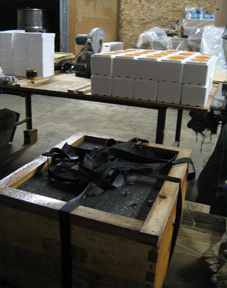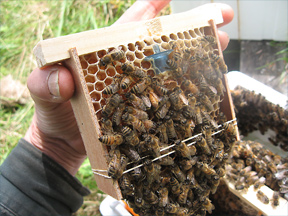My previous blog post was about shaking bees to put into mating nucs in our on-going adventures in queen rearing at Bruce Bowen’s Bees in Mt. Vernon, Washington. This blog is about uniting those bees with fully-formed queen cells in mini-nucs.
Yes, it’s a bit out of order, because we were able to begin with queen cells raised by bee breeder and researcher Sue Cobey (http://beebiology.ucdavis.edu/PEOPLE/susancobey.html)
We picked up the cells at the Washington State University Research Station in Mt. Vernon. The cells, on their cell bars were transported to Bruce’s honey house in a large cooler where they rested upon a hot water bottle and a towel.
The Background:
- The mini nucs are about the size of half a shoe box.
- There is a section for syrup and another for three tiny drawn combs.
- Each tiny comb is half the height of a deep frame, and almost one-third the length of the frame (A bit of bad engineering in the latter part. When a deep frame of drawn comb is cut, you always wind up with a bit left over.)
The Set Up:
- The mini nucs were filled with syrup before the queen cells arrived.
- Each syrup section had 3 or 4 styrofoam packing pellets floating in it to act as rafts for the bees. (We did check to make sure the pellets were styrofoam and not the biodegradable corn-based pellets – a dissolving raft would be of no use to any bee).
The box of nurse bees were set beside the work table. They were scooped out of the box using a clean Spam can. It gives just the right amount of nurse bees.
The Production Semi-Circle:
We tried for a line, but beekeepers seldom walk, or stand, on the straight and narrow.
Most everyone worked without gloves. That can sound a bit nervous-making at first, but the bees being placed with the queen cells are nurse bees and they have nothing to protect until they unite with their queen cells.
Person 1: Removed 2 frames from one end the mini-nuc. We realized that this could be best served in the Set-Up stage. With the well-drawn frames stacked in front of Person #2.
Person 2: Put a queen-cell onto what would be the center frame
Persons 3 and 4:
a) Bees were scooped off of the combs on to which they had been poured in the beeyard.
b) They were then poured into the mini-nuc.
We found this takes 2 people to go quickly: one to hold the frame up, the other to scoop and pour.
Person 2 (again, not a typo): Put the mini-frame with the queen cell into the nuc
Person 1 (again) : put the final frame in and closed the mini-nuc. This happens fast.
Person 5 : Walked the mini-nuc over to the pallet where it would spend the next 2 days, in a cool, dark environment.
The Mini-Nuc Stacks:
The mini-nucs were placed on regular shipping pallets, in a dark, quiet corner of the room
They were stacked 3 mini’s tall, but separated by ample space for air-flow.
Two fans were left on to keep the mini-nucs cool.
We drew on all the mini-nucs to hopefully help the bees determine which nuc was theirs. And there we left them for 2 days.
On the 2nd day, we moved them to their mating yard.
We left them alone for about 10 days then went to check on them. The majority seem to have taken brilliantly.
Coming next: four of us will take a shot at grafting and putting those laying queens into cages so they can be distributed. Speaking for myself, I expect there will be something of a learning curve in the grafting, but it should be fun….







2 Responses to Workers and Queen Cells Unite! Adventures in Queen Rearing, Part 2